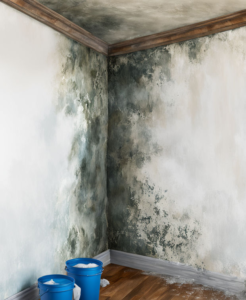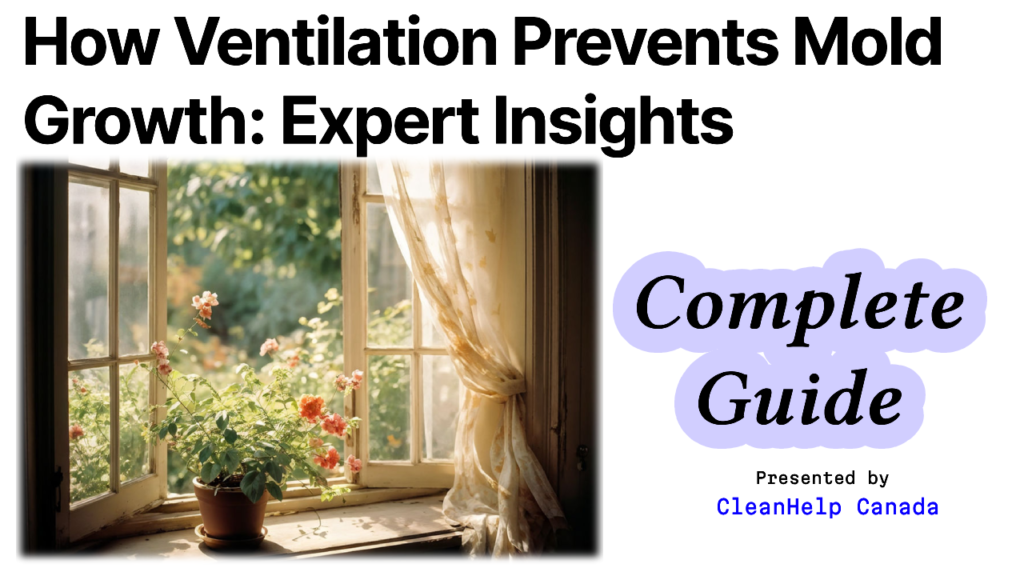Mold growth is an unwelcome guest in any home, often creeping in unnoticed until it becomes a significant problem. In the humid climate of London, Ontario, where seasonal changes can lead to increased moisture levels, preventing mold growth is essential for maintaining a healthy living environment. One of the most effective ways to prevent mold is through proper ventilation. CleanHelp Canada, a trusted provider of apartment cleaning services and a bonded cleaning service in London, Ontario, understands the importance of keeping your home free from mold. In this blog, we’ll explore why ventilation is so crucial in its prevention and provide expert insights on how to keep your home mold-free.
Understanding Mold and Its Causes

Mold is a type of fungus that thrives in damp, warm, and humid environments. It can grow on almost any surface, including walls, ceilings, carpets, and furniture. Once it spores find a suitable environment, they multiply rapidly, often leading to health issues such as respiratory problems, allergies, and even more severe conditions for those with weakened immune systems.
Why Ventilation Matters
Ventilation plays a critical role in controlling the moisture levels within your home, which is the primary factor in mold growth. Without adequate ventilation, moisture from everyday activities like cooking, showering, and even breathing can accumulate, creating the perfect breeding ground for mold.
Proper ventilation helps to:

- Reduce Humidity: By allowing moist air to escape and fresh air to enter, ventilation keeps humidity levels in check, making it harder for mold to thrive.
- Prevent Condensation: Good airflow prevents the buildup of condensation on windows, walls, and other surfaces, which is a common cause of its growth.
- Improve Air Quality: Ventilation ensures that stale, moist air is replaced with fresh, clean air, improving the overall air quality in your home.
Key Areas Where Ventilation Is Essential
Not all areas of your home are equally vulnerable to mold. Some spaces require more attention when it comes to ventilation.
1. Bathrooms
Bathrooms are one of the most common places for mold growth due to the high levels of moisture from showers and baths. Ensure your bathroom has an effective exhaust fan to remove moist air and consider leaving the door or window open after using the shower to allow additional airflow.
2. Kitchens
Cooking generates a significant amount of moisture, especially when boiling water or using the dishwasher. Use a range hood or exhaust fan to vent steam and moisture outside. If your kitchen has windows, opening them during and after cooking can help reduce humidity.
3. Basements
Basements are naturally prone to dampness due to their location below ground level. Ensure your basement has proper ventilation, and consider using a dehumidifier if the humidity levels remain high. Regularly check for any signs of water leaks, as these can quickly lead to mold growth.
4. Attics
Poorly ventilated attics can trap warm, moist air, leading to mold growth on the roof’s interior and insulation. Ensure your attic has adequate ventilation, such as ridge vents or soffit vents, to allow air to circulate freely.
Seasonal Considerations for Mold Prevention in London, Ontario
London, Ontario, experiences a range of weather conditions throughout the year, each presenting unique challenges for mold prevention.
Spring and Summer
During the warmer months, high humidity levels can create ideal conditions for mold growth. Use air conditioning and fans to maintain airflow and reduce indoor humidity. It’s also essential to inspect areas like basements and crawl spaces, which can become damp from increased groundwater levels.
Fall and Winter
In the colder months, condensation is a common issue, especially on windows and in poorly insulated areas. Ensure your home is adequately insulated to prevent cold spots where condensation can form. Consider using a dehumidifier in areas prone to moisture buildup, such as basements.
Expert Tips for Effective Ventilation
Implementing effective ventilation strategies can significantly reduce the risk of mold in your home. Here are some expert tips to help you keep your living space healthy:
- Use Exhaust Fans Consistently
- Always use exhaust fans in bathrooms and kitchens during and after activities that generate moisture. These fans should vent directly outside and not into other parts of the house.
- Open Windows Regularly
- Whenever weather permits, open windows to allow fresh air to circulate throughout your home. Even in colder months, brief periods of ventilation can help reduce moisture buildup.
- Install a Ventilation System
- If your home has chronic moisture issues, consider installing a whole-house ventilation system. These systems can regulate airflow and humidity levels throughout your home, offering a more permanent solution to its prevention.
- Inspect and Maintain HVAC Systems
- Regularly check and maintain your heating, ventilation, and air conditioning (HVAC) systems to ensure they are functioning correctly. Replace filters as recommended to keep air flowing freely and cleanly.
- Consider a Dehumidifier
- In areas where humidity is consistently high, such as basements, a dehumidifier can help maintain moisture levels within a safe range, making it harder for mold to grow.
Additional Steps for Mold Prevention
While ventilation is critical, there are additional steps you can take to prevent growth in your home:
- Fix Leaks Promptly: Water leaks are a significant source of moisture. Address any leaks in roofs, walls, or plumbing as soon as they are detected.
- Clean and Dry Spills Immediately: Standing water, even from minor spills, can lead to mold growth if left unattended. Clean up and dry any spills right away.
- Monitor Indoor Humidity Levels: Use a hygrometer to monitor indoor humidity. Aim to keep it below 60% to discourage mold growth.
- Declutter and Clean Regularly: Mold can grow on surfaces like cardboard, wood, and paper. Regular cleaning and decluttering can help reduce the amount of material on which it can feed.
The Role of Professional Services
Despite your best efforts, mold can sometimes still find a way into your home. In such cases, professional cleaning services like CleanHelp Canada can be invaluable. Our team specializes in the prevention and remediation, ensuring that your home remains a safe and healthy environment. We use advanced techniques to detect and eliminate it, along with strategies to prevent its return.
Our services also include thorough cleaning of areas prone to mold, such as bathrooms, basements, and attics, providing you with peace of mind that your home is protected. Whether you need a one-time deep clean or regular maintenance, CleanHelp Canada is here to help with apartment cleaning services and more.
Conclusion: Keep Your Home Mold-Free with Proper Ventilation
Mold prevention is a critical aspect of home maintenance, especially in areas like London, Ontario, where humidity and seasonal changes can increase the risk of mold growth. By ensuring your home is well-ventilated, you can significantly reduce the likelihood of mold taking hold. Remember to use exhaust fans, open windows when possible, and consider professional services for areas that are challenging to keep dry.
At CleanHelp Canada, we are committed to helping you maintain a clean, healthy home. Our expert team is ready to assist with all your cleaning and mold prevention needs, ensuring your living space is safe and comfortable year-round. Whether you’re looking for apartment cleaning services or a bonded cleaning service, we’ve got you covered.
For more information on how we can help, visit our website at cleanhelpcanada.ca.
